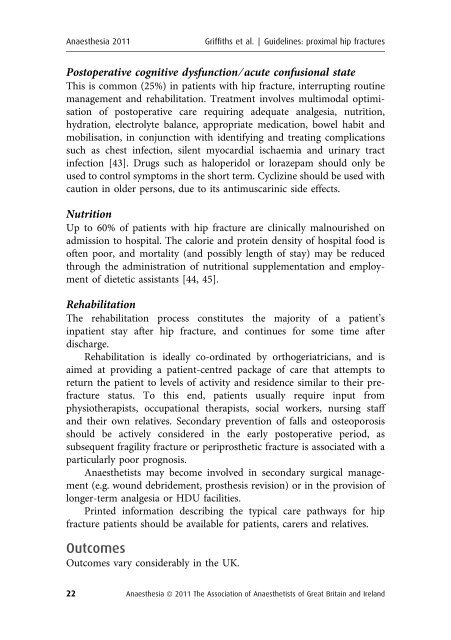Management of Proximal Femoral Fractures 2011 - aagbi
Management of Proximal Femoral Fractures 2011 - aagbi
Management of Proximal Femoral Fractures 2011 - aagbi
Create successful ePaper yourself
Turn your PDF publications into a flip-book with our unique Google optimized e-Paper software.
Anaesthesia <strong>2011</strong>Griffiths et al. | Guidelines: proximal hip fracturesPostoperative cognitive dysfunction ⁄ acute confusional stateThis is common (25%) in patients with hip fracture, interrupting routinemanagement and rehabilitation. Treatment involves multimodal optimisation<strong>of</strong> postoperative care requiring adequate analgesia, nutrition,hydration, electrolyte balance, appropriate medication, bowel habit andmobilisation, in conjunction with identifying and treating complicationssuch as chest infection, silent myocardial ischaemia and urinary tractinfection [43]. Drugs such as haloperidol or lorazepam should only beused to control symptoms in the short term. Cyclizine should be used withcaution in older persons, due to its antimuscarinic side effects.NutritionUp to 60% <strong>of</strong> patients with hip fracture are clinically malnourished onadmission to hospital. The calorie and protein density <strong>of</strong> hospital food is<strong>of</strong>ten poor, and mortality (and possibly length <strong>of</strong> stay) may be reducedthrough the administration <strong>of</strong> nutritional supplementation and employment<strong>of</strong> dietetic assistants [44, 45].RehabilitationThe rehabilitation process constitutes the majority <strong>of</strong> a patient’sinpatient stay after hip fracture, and continues for some time afterdischarge.Rehabilitation is ideally co-ordinated by orthogeriatricians, and isaimed at providing a patient-centred package <strong>of</strong> care that attempts toreturn the patient to levels <strong>of</strong> activity and residence similar to their prefracturestatus. To this end, patients usually require input fromphysiotherapists, occupational therapists, social workers, nursing staffand their own relatives. Secondary prevention <strong>of</strong> falls and osteoporosisshould be actively considered in the early postoperative period, assubsequent fragility fracture or periprosthetic fracture is associated with aparticularly poor prognosis.Anaesthetists may become involved in secondary surgical management(e.g. wound debridement, prosthesis revision) or in the provision <strong>of</strong>longer-term analgesia or HDU facilities.Printed information describing the typical care pathways for hipfracture patients should be available for patients, carers and relatives.OutcomesOutcomes vary considerably in the UK.22 Anaesthesia ª <strong>2011</strong> The Association <strong>of</strong> Anaesthetists <strong>of</strong> Great Britain and Ireland
















